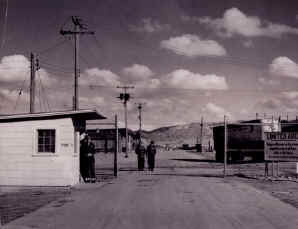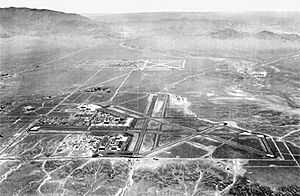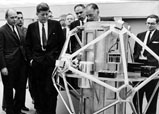Sandia Base facts for kids
Sandia Base was a very important place for nuclear weapons in the United States Department of Defense from 1946 to 1971. It was located in Albuquerque, New Mexico. For 25 years, Sandia Base and its smaller partner, Manzano Base, worked on atomic weapons. This included research, development, design, testing, and training. These activities started during World War II with the Manhattan Project. Nuclear weapons were also built, put together, and stored at Sandia Base. The base played a big part in the United States' ability to prevent war during the Cold War. In 1971, it joined with Kirtland Air Force Base.
Contents
Where Was Sandia Base Located?
Sandia Base was in the southeast part of Albuquerque. It was next to Kirtland Air Force Base on the west and the Sandia Mountains on the east. There were security gates on Gibson Avenue SE and Wyoming Boulevard SE.
How Sandia Base Started
Sandia Base was built on land that used to be Oxnard Field. This was once the main airport for Albuquerque. Another airport took most of the flights in the 1930s. The U.S. Army bought Oxnard Field after 1939.
Becoming a Nuclear Weapons Center
After World War II, leaders like Leslie Groves and J. Robert Oppenheimer faced a challenge. They needed to change the wartime effort of building bombs into a stable, long-term operation. This new operation would produce and maintain the nation's nuclear weapons. Many scientists wanted to go back to their normal lives.
To solve these problems, the old Oxnard Field in Albuquerque became the main nuclear weapons site. A group called Z Division, led by Dr. Jerrold R. Zacharias, was in charge of designing, testing, and assembling atomic bombs. Los Alamos, where they were working, didn't have enough space. Also, Z Division needed to work closely with the military.
So, the decision was made to move Z Division to Oxnard Field. By September 1945, parts of Z Division had already moved there. By 1946, the site was known as "Sandia Base" because of the nearby Sandia Mountains.
In January 1947, the rest of Z Division moved to Sandia Base. That same month, the Armed Forces Special Weapons Project (AFSWP) was created. This group took over all military tasks related to the Manhattan Project. AFSWP brought strict secrecy to Sandia Base, just like at Los Alamos. In 1947, people wondered what was happening at Sandia Base. The military only said that the activities were secret under the Atomic Energy Act.
The Armed Forces Special Weapons Project
AFSWP was responsible for all military tasks related to atomic energy. They worked with the Atomic Energy Commission. General Groves was in charge and reported directly to the Joint Chiefs of Staff. He sent Colonel Gilbert M. Dorland to Sandia Base to check on the bomb-building efforts.
Dorland gathered about sixty young Army officers, who were called the "Sandia Pioneers." They oversaw the bomb assembly work. Dorland also started a nuclear weapons training school at Sandia Base.
The Pioneers learned how to put atomic bombs together. They also practiced loading them onto planes for long missions. They used Boeing B-29 Superfortress bombers, similar to the planes that dropped the first atomic bombs on Japan in 1945. The Pioneers and the 509th Bombardment Group flew practice missions from Kirtland AFB to Wendover, Utah.
On April 12, 1950, a B-29 plane from the 509th Bombardment Group crashed at Sandia Base. This happened shortly after takeoff. Thirteen crew members died. The military kept the crash site very secret. They officially said the B-29 was on a "navigation training flight."
At Sandia Base, the Pioneers worked with Sandia Laboratory and the AEC. They improved the design, assembly, storage, and delivery of atomic weapons. In 1948, the Pioneers helped with Operation SANDSTONE. This was a series of atomic bomb tests in the atmosphere at Eniwetok Atoll in the Marshall Islands.
The SANDSTONE tests were successful. However, it was clear that a test site in the United States was needed. AFSWP did a secret study called Project Nutmeg to find such a place. In 1950, AFSWP decided that a site in Nevada was the best spot. President Truman approved this location, known as Frenchman Flat.
The first atomic test in the U.S. after the war happened on January 27, 1951. A weapon built at Sandia Base was dropped from a Boeing B-50 Superfortress bomber. This was the successful "Able" test. After that, about 927 nuclear tests happened at what is now the Nevada Test Site. AFSWP and its later groups from Sandia Base supported these tests.
A U.S. Naval Air Detachment was assigned to Sandia Base in June 1949. It was renamed several times, eventually becoming the Naval Weapons Evaluation Facility (NWEF) in 1961. Before NWEF stopped flight tests in 1992, it had checked the safety of 76 versions of 32 different Navy aircraft that could carry nuclear weapons.
After accidents on the USS Oriskany in 1966 and the Forrestal in 1967, NWEF created safety rules. These rules helped safely store, handle, and transport non-nuclear weapons like bombs, torpedoes, and missiles.
In 1959, AFSWP was renamed the Defense Atomic Support Agency (DASA). Sandia Base became the Headquarters Field Command, DASA. Over the next 12 years, Army, Navy, and Air Force officers led Field Command.
Sandia Base personnel helped with two major incidents where nuclear weapons were lost and then found. In 1966, a Boeing B-52 Stratofortress bomber and a Boeing KC-135 Stratotanker plane crashed over the Mediterranean Sea near Spain. This was called the Palomares incident. Three missing nuclear weapons were found on land in Palomares, Spain. The fourth was found in the sea after a long search.
The second incident happened in 1968. A B-52 bomber crashed near Thule, Greenland. Three weapons were found, but a fourth is believed to still be in the ocean.
Important political figures often visited Sandia Base. President John F. Kennedy visited on December 7, 1962. Vice President Hubert H. Humphrey toured the facilities on April 17, 1966.
In 1971, DASA was renamed the Defense Nuclear Agency. The activities stayed at Sandia Base, which then merged into Kirtland Air Force Base. The Defense Nuclear Agency later became the Defense Special Weapons Agency (DSWA) in 1996. DSWA was closed on October 1, 1998, and its tasks moved to the new Defense Threat Reduction Agency (DTRA).
Sandia National Laboratories
After moving to Sandia Base, Los Alamos Laboratory's Z Division grew to almost 500 people. It became a separate part of Los Alamos on April 1, 1948. This new group was called Sandia Laboratory. It continued to grow to about 1000 employees by mid-1948.
The University of California, which had managed Los Alamos for a long time, no longer wanted to be involved in building nuclear weapons. So, in 1949, AT&T's manufacturing company, Western Electric, took over the management. They did this without making a profit. Sandia Corporation, a company owned by Western Electric, was formed to manage the lab.
AT&T managed the contract until 1993. Then, Martin Marietta (now Lockheed Martin) took over. Sandia Laboratory was the largest organization at Sandia Base. It became Sandia National Laboratories in 1979. Today, it has facilities in Albuquerque and Livermore, California. The organization continues to explore new research areas, like renewable energy.
Manzano Base
In August 1947, a newspaper claimed the military was building a secret base. It said the base had huge underground rooms for atomic weapons defense. This new base was supposedly in the Manzano Mountains southeast of Sandia Base. The military said that operations near Sandia Base were top-secret. In fact, AFSWP was building one of several bases across the country for storing nuclear weapons. AFSWP called this base "Site Able."
Construction of Site Able was delayed by a worker strike. On February 22, 1952, the completed Site Able was renamed Manzano Base. It was given to the Air Force to control. The newspaper story seemed to be right about the general nature of the base. Secure bunkers could be seen by people who went to a nearby camping area. However, the military never officially confirmed what Manzano Base was for. Manzano has since been identified as the first of six original National Stockpile Sites (NSS) for nuclear weapons.
On July 1, 1971, Manzano Base merged with Sandia Base into Kirtland Air Force Base.
Other Events at Sandia Base
On March 8, 1950, a fire started in the stockade (a prison area) at Sandia Base. Fourteen prisoners died. Several officers and firefighters were seriously hurt.
On May 22, 1957, a B-36 plane was carrying a nuclear weapon from Biggs AFB to Kirtland AFB. It dropped the weapon while approaching Kirtland AFB. The weapon hit the ground 4.5 miles south of the Kirtland control tower. It was completely destroyed by its high explosive material. This created a crater 12 feet deep and 25 feet wide.
Life at Sandia Base
Sandia Base had military personnel from all branches of the armed forces. It also had civilian employees from the Department of Defense. Sandia Lab brought even more civilians to the base.
Most of the base was restricted, but other parts were like any other U.S. military base. By the 1950s, there were homes for thousands of military families. They could shop, go to school, play, and worship there. The Army was in charge of running these parts of the base.
Housing for military families was in three areas. Zia Park was in the southwest corner. Pershing Park was on the northwest side. East of Wyoming Boulevard was an area called "The Loops" because the streets were circular.
There were two schools on the base. Sandia Base Elementary School and Wherry Elementary School. Both schools were, and still are, part of the Albuquerque Public Schools system. Older children from Sandia Base went to Van Buren Junior High School and Highland High School.
Sandia Base also had an officers club, a club for non-commissioned officers (NCOs), a commissary (grocery store), a base exchange (department store), a movie theater, a swimming pool, a library, and a teen club. There was also a club for civilian employees. The base had two chapels, a hospital, and a pre-school.
Joining Kirtland Air Force Base
On July 1, 1971, Sandia Base and Manzano Base joined Kirtland Air Force Base. Kirtland Air Force Base was their neighbor to the west. This merger happened at the same time DASA changed to the Defense Nuclear Agency. The Air Force then took over the main responsibility for the nation's military nuclear weapons program.
See also
 In Spanish: Base Sandia para niños
In Spanish: Base Sandia para niños




